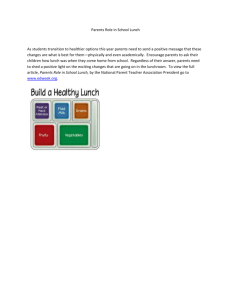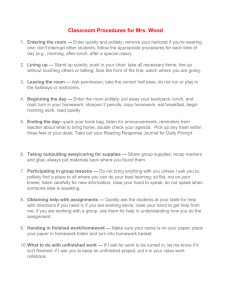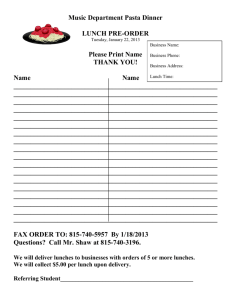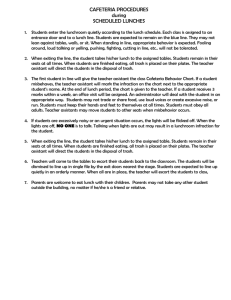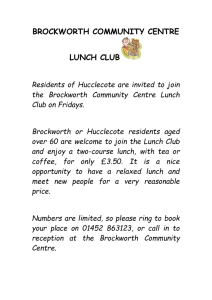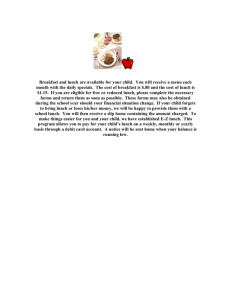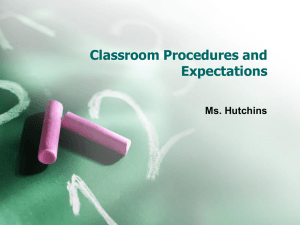30-Classroom-Procedures-to-Head-Off-Behavior
advertisement
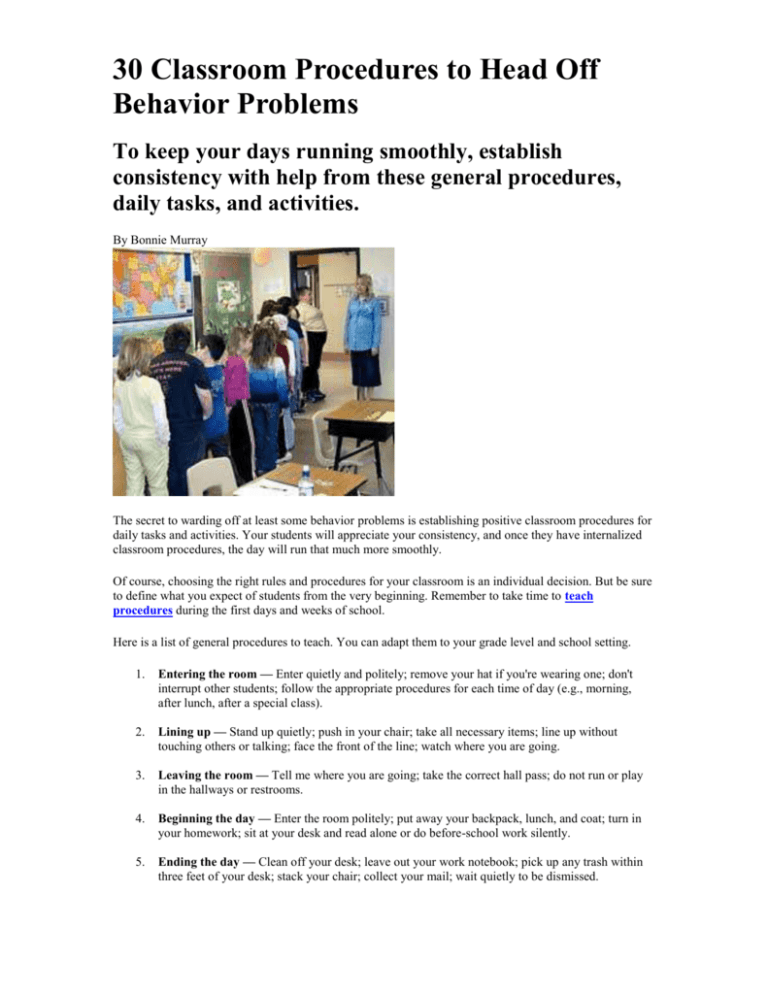
30 Classroom Procedures to Head Off Behavior Problems To keep your days running smoothly, establish consistency with help from these general procedures, daily tasks, and activities. By Bonnie Murray The secret to warding off at least some behavior problems is establishing positive classroom procedures for daily tasks and activities. Your students will appreciate your consistency, and once they have internalized classroom procedures, the day will run that much more smoothly. Of course, choosing the right rules and procedures for your classroom is an individual decision. But be sure to define what you expect of students from the very beginning. Remember to take time to teach procedures during the first days and weeks of school. Here is a list of general procedures to teach. You can adapt them to your grade level and school setting. 1. Entering the room — Enter quietly and politely; remove your hat if you're wearing one; don't interrupt other students; follow the appropriate procedures for each time of day (e.g., morning, after lunch, after a special class). 2. Lining up — Stand up quietly; push in your chair; take all necessary items; line up without touching others or talking; face the front of the line; watch where you are going. 3. Leaving the room — Tell me where you are going; take the correct hall pass; do not run or play in the hallways or restrooms. 4. Beginning the day — Enter the room politely; put away your backpack, lunch, and coat; turn in your homework; sit at your desk and read alone or do before-school work silently. 5. Ending the day — Clean off your desk; leave out your work notebook; pick up any trash within three feet of your desk; stack your chair; collect your mail; wait quietly to be dismissed. 6. Taking out/putting away/caring for supplies — Share group supplies; recap markers and glue; check the number written on the supplies to make sure they belong in your group basket; if something belongs to another group, return it to them quietly. 7. Participating in group lessons — Do not bring anything with you unless I ask you to; politely find a place to sit where you can do your best learning; sit flat, not on your knees; listen carefully for new information; raise your hand to speak; do not speak when someone else is speaking. 8. Obtaining help with assignments — Quietly ask the students at your table for help with directions if you need it; if you are working alone, raise your hand to get help from me; if you are working with a group, ask them for help in understanding how you do the assignment. 9. Handing in finished work/homework — Make sure your name is on your paper; place your paper upside down in the "finished work" or "homework" basket. 10. What to do with unfinished work — If I ask for work to be turned in, let me know if it isn't finished; if I ask you to keep an unfinished project, put it in your class work notebook. 11. When and how to use the school restroom — If I am not teaching the whole group, stand by the classroom door with your hand raised; if I say "no," wait for a better class time to go; if I nod, leave the room quietly; do not play in the restroom; return to class before two minutes have passed (promptly). 12. When and how to use the drinking fountain or sink — When I am not teaching the whole group, you may get a drink; take only a three-second drink; you may bring a water bottle to keep on your desk; if you need to wash your hands, use only a little soap; wipe up any water you spill. 13. When and how to use the pencil sharpener — At the beginning of each assignment, the person I've chosen to be the "Pencil Sharpener" will invite you to have him or her sharpen your pencil; if your pencil breaks during an assignment, use a community pencil; only the "Pencil Sharpener" can run the sharpener and empty it. 14. Being a classroom helper; learning a classroom job — If you get a job on Monday, see the person who did the job last week during silent reading time, ask him or her for the job description card, and have him or her help you on the first day. For the rest of the week, it is your responsibility to remember to do your job. 15. Getting into work groups — Take all the materials you will need; greet each other; complete the task doing your personal best; make sure each person signs the project; thank the others in your group. 16. Using the classroom library — When I am not teaching the whole group, you may check out a book. To do so, select a book (you only have three minutes at the class library) and sign out the book on the sign-out sheet. Take good care of the book; when you are finished, return the book to the basket and check it off the list. 17. Handling seatwork pages — As soon as you get a paper, print your first name and last initial at the top on the right-hand side and today's date at the top on the left-hand side. 18. Preparing for lunch — Wait quietly at your desk; when your lunch number is called, get your lunch or lunch money and line up in order; take everything with you, as you will not be allowed to come back to the classroom after we leave for lunch; while you're waiting in line, think about the way you need to behave in the lunchroom and on the playground; while you're at lunch and at recess, find one person who is behaving responsibly and be prepared to tell the class what you noticed. 19. Getting a tissue — You may get a tissue from the closest of the four tissue boxes whenever you need one; you don't even have to ask; throw the used tissue away immediately; make sure it lands in the trash can; get right back to work. 20. Lunch count/attendance — "Hot lunch" means you are having school lunch; "cold lunch" means you brought a lunch from home; move your attendance tag/magnet/clothespin to the "hot lunch" or "cold lunch" sign/spot; wait patiently for your turn. 21. Throwing away trash — You may throw away trash whenever you need to if I am not teaching the whole group; do not play basketball with your trash; make sure all trash lands in the can; pick up trash even if it isn't yours. 22. Turning in lost items — Ask the people around you if they lost the item you found; if not, write your name and the date on a slip of paper and tape the item to it; if it is money or something valuable, put the item and slip on my desk for safekeeping; if not, put it in the Lost and Found box; give yourself a "pat on the back" for being honest. 23. Locating lost items — Ask the people around you if they found the item you lost; if not, check the Lost and Found box; if it is not there, ask me at a time when I'm not teaching the class; if you find it, thank the person who turned it in; next time, try to take care of your things. Consider going through the Lost and Found box at the end of each month with the whole class. If an item remains unclaimed, give it to the person who turned it in. 24. Pledge — When you hear/see the signal, stop what you're doing immediately and stand up; place your right hand over your heart; say the Pledge of Allegiance respectfully; during the 30 seconds of silence, quietly think about the things you want to learn today and how you will act in class and on the playground. 25. Visitors in the classroom — When visitors enter the room, let the designated classroom "host" or "hostess" greet them; when the host or hostess rings the chimes, get ready to listen to and look at the visitor — a smile is great!; when the host or hostess introduces the visitor, say, "Welcome to our class, __________"; remember, most visitors are here to watch you learn, so be ready to explain what you are working on; treat visitors respectfully. 26. Fire drill — Stop everything; stand up and head for the door quickly, but without running or pushing; do not cover your ears; do not make any side trips; the classroom "fire chief" takes the fire drill packet and leads the line outside; the second person in line holds the classroom door for the rest of the class; the third person in line holds the outside door only for our class, then becomes the last person in line; wait patiently, calmly, and quietly in line outside until we are allowed to go back to what we were doing. 27. Signals for attention — When I need your attention, I will ring the chimes (or sound the rain stick, open the music box, etc.); as soon as you hear the signal, stop what you are doing, look at me, and listen for directions. 28. Helping other students — In a cooperative classroom, it is good to help one another; if someone needs help with directions or reading an assignment, help him or her if you are able; if someone needs help with understanding the problem, tell him or her to ask me for help; never put down another student who asks for help. 29. Organizing desk — Remove all loose papers; decide if they should go home or stay at school; put papers that should stay at school in the front pocket of your work notebook; put pencil or art supplies in your school box; put your folders and work notebook on the left side of your desk tray; everything else goes on the right side; pick up your trash. 30. What to do during free time — If you finish an assignment, first work on any unfinished assignments that are in the front pocket of your work notebook; when you finish those, you may choose to do your classroom job, read a book, write a story, illustrate a book, make up math problems, work on a research project, peer-tutor someone who needs your help, or create a song about what the class is studying.
